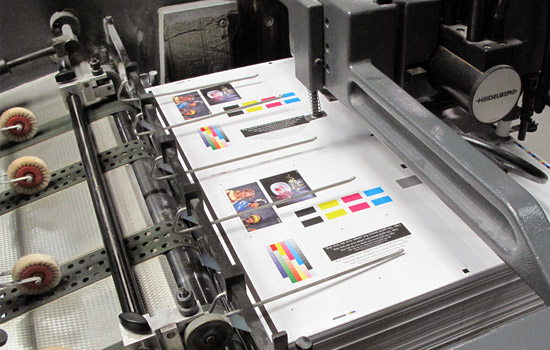Mellon Foundation funds digital-print preservation
Grant will support continued research in digital print preservation
The image above shows printing of the test targets for the DP3 continuation project on one of the printing technologies—offset lithography.
The Image Permanence Institute at Rochester Institute of Technology has received a grant for $600,000 from the Andrew W. Mellon Foundation in support of continued research into the preservation of digitally printed materials in cultural heritage institutions.
This is a three-year extension of the Image Permanence Institute’s previous work on the DP3 Project: Digital Print Preservation Portal, funded by both the Andrew W. Mellon Foundation and the Institute for Museum and Library Services.
In the first DP3 project, the Image Permanence Institute performed research on the stability of digitally printed materials subjected to a specific set of deterioration forces—heat, humidity, pollution and light. The results of these investigations are being published on the DP3 website, a website created for the project.
Additional Mellon funding will permit further study of the deteriorating effects of abrasion, humidity and light and their prevention. The project also initiates two new areas of study: the thermal stability of digital-print colorants and the permanence of bound digitally printed objects such as periodicals and monographs. Ultimately, the grant from the Mellon Foundation will allow the Image Permanence Institute to refine the data sets upon which best practices for the long-term care of digitally printed materials can be based.
Virtually all forms of scholarly communications now depend on new, untested printing technologies. Collecting institutions, including libraries, archives and museums, are routinely incorporating these materials into their collections. This has raised new questions about institutional preservation policies including handling risks and environmental requirements. Initial research identified that the greatest threats to these modern materials include airborne pollutants, light, high humidity, abrasive or chemically reactive enclosures, poor handling techniques and floods. The next phase of research will quantify the specific levels of stress needed to initiate objectionable or irreversible damage.
Final results of this research will be posted on the DP3 website, distributed to the field in a newsletter and documented in technical papers that will be submitted to relevant professional journals for publication. In addition, the Image Permanence Institute will present the findings to the International Organization for Standardization’s Committee on Physical Properties and Permanence of Imaging Materials to serve as a basis for improving their current storage recommendations for digitally printed materials with science-based recommendations for imaging media storage standards.
About the Image Permanence Institute
The Image Permanence Institute, part of RIT’s College of Imaging Arts and Sciences, is a nonprofit preservation research laboratory and a recognized world leader in the development and deployment of sustainable practices for the preservation of images and cultural property. To learn more about IPI, go to the RIT Image Permanence Institute webpage.









